Unused content in Phoenix Wright: Ace Attorney — Justice for All

In this series of articles I will try to list and describe all unused and cut content from GBA, NDS, 3DS and SW/PS4/XOne versions of the first Phoenix Wright Ace Attorney trilogy.
Here we will look into Phoenix Wright: Ace Attorney — Justice for All. Things you will see below were discovered by me when I was fan-translating the second game.
Generally, most unused content mentioned here could be found in GBA, NDS and 3DS versions. There are exceptions thought, for instance, the GBA version does not feature unused English dialogs since it was released in Japan only.
This article contains spoilers.
Unused Dialogs: Case 2, Part 1, Investigation
Dialog #1
Place: Wright & Co. Law Offices.
Time: Upon returning to Wright & Co. Law Offices and examining the newspaper on the desk (after visiting Kurain village).
| Unused English Dialog | Unused Japanese Dialog |
|
Phoenix:
...That newspaper clipping
Dr. Grey must have forgotten
Newspaper Clipping 1 added |
Naruhodo:
‥‥新聞記事の切り抜きが
きのうの夜、霧崎先生が
証拠品《新聞記事・1》を |
Commentary: In the final game when the player returns to Wright & Co. Law Offices after visiting Kurain village, the game automatically engages the following sequence:
| Regular Dialog |
|
June 20
Phoenix: But it's only been one day... (Oh, that's right!)
Where's that newspaper
...Ah, here it is. Right on
(This is the only thing he
Newspaper Clipping 1 added |
Then the newspaper disappears from the desk and there is no way to examine it and activate the unused dialog.
In the final game the one who brings attention to this newspaper is Gumshoe. The problem is the player can visit Wright & Co. Law Offices long before talking to Gumshoe, and in this case the sudden mention of some newspaper looks rather confusing.
But judging from the unused dialog, if the player didn't talk to Gumshoe in the earlier version of the script, the game would not engage the regular dialog above — instead the player would be able to examine and get the newspaper by themselves. But if they discussed it with Gumshoe, Phoenix would automatically obtain the newspaper from the desk upon returning to the office, just like in the final game.
It could also be just a simple bug, where the developers accidentally forced the regular dialog to appear at any point during the gameplay.
Dialog #2
Place: Side room of the Fey Manor.
Time: When confronting Ini Miney after she "actives" her Psyche-Locks.
| Unused English Dialog | Unused Japanese Dialog |
|
Phoenix:
▼Select your answer▼
Phoenix: |
Naruhodo:
▼ぼくのコタエを示そう▼
Naruhodo: |
Commentary: In the final game the player must present Maya's Magatama in order to start the process of breaking the Psyche-Locks, but those unused lines above suggest that during the first Psyche-Lock encounter in Case 2 the game would directly offer it to the player instead — probably to get their attention and thus avoid confusion associated with the newly introduced game feature.
There is also the possibility that this was the original way to start the Psyche-Lock breaking sequence.
The "Try to break it" and "Don't try" graphics are still present in the game files, see the "Unused Choices" section.
Unused Dialogs: Case 3, Part 1, Investigation
Dialog #1
Place: Big Top.
Time: Upon presenting Ben's puppet, Trilo, to Regina.
| Unused English Dialog | Unused Japanese Dialog |
|
Regina:
He's not moving...
Maya: |
Mirika:
‥‥動かないね。
Mayoi: |
Commentary: In the final game after the player obtains Trilo, Regina disappears from the Big Top location, and since she does not reappear until after the puppet is returned to Ben, there is no opportunity to present this item to her.
Dialog #2
Place: Wright & Co. Law Offices.
Time: When showing a Berry Big Circus member profile to Maya.
| Unused English Dialog | Unused Japanese Dialog |
|
Maya: And so incredibly strange...
Phoenix:
Maya:
Phoenix: |
Mayoi: ヘンなヒトばっかり。
Naruhodo:
Mayoi:
Naruhodo: |
Commentary: This dialog probably occurred when the player showed Maya a profile of those circus members that had no unique dialogs assigned to them, but in the final game Maya has unique reaction to each one of them, and so this dialog is left unused.
Placeholder Captions/Icons
In the Japanese version of Ace Attorney for Nintendo DS/3DS each item in the Court Record is comprised of two icons and two separate boxes (images) that contain caption/age and description data respectively.


In the English version icons and captions are stored in the same way, but due to the fact that English text requires more space, descriptions got completely new boxes, while the original description boxes where repurposed to contain the age data and additional info not found in the Japanese version.



Items that only appear on the upper screen have the smaller versions of their icons too (smaller icons are only used to represent evidence in the Court Record), but they were never meant to be used actually: the developers just batch converted all big icons into the smaller ones and never bothered to remove them afterwards.
Strictly speaking, Ace Attorney — Justice for All does not contain any unused evidence, but it does contain captions for certain items that are only displayed on the upper screen for illustration purposes. Most likely they were never meant to appear in the Court Record as actual evidence since their age and description boxes are empty in both English and Japanese versions — moreover in the GBA version their description boxes have the word "Dummy" in them.
Case 1 — Maya's Cell Phone
Caption (ENG/JAP), Small Icon (not used):

Commentary: Maya's cell phone makes its appearance in the first case.
Case 2 — Received from Lotta Hart
Caption (ENG/JAP):

Commentary: At first it is not quit clear what this caption was supposed to mean. It even looks like someone accidentally inserted the wrong text. The answer to this curiosity could be found in the GBA version, though:

メモ・・ダミー
(Memo from Lotta...
Dummy)
As it turns out, the Japanese text was so long it got into the description field. When the game was ported to Nintendo DS only the first line was carried over, making its original meaning lost.
This memo is actually mentioned in the game:
| Regular Dialog |
|
Lotta:
Phoenix:
Lotta: |
When she says "I'll give ya the clinic's address", a crumpled memo icon appears on the screen:
Case 2 — Manfred von Karma
Big/Small Icon (both not used):Commentary: Seemingly the only big icon that never appears in the game. It was definitely not intended for the Court Record profile section — there is no empty caption or description for it after all — rather it was meant to be shown when someone mentioned Karma Sr. during conversations.
Case 3 — Grapes
Caption (ENG/JAP), Small Icon (not used):

Commentary: This grape appears when protagonists encounter Moe for the first time.
Case 3 — Milk
Caption (ENG/JAP), Small Icon (not used):

Commentary: A carton of milk given by Regina to Max during court proceedings.
Case 3 — Playing Card
Caption (ENG/JAP), Small Icon (not used):

Commentary: A playing card used by Max.
Case 3 — Playing Cards
Caption (ENG/JAP), Small Icon (not used):

Commentary: A pack of playing cards used by Max.
Case 3 — Tiger
Caption (ENG/JAP), Small Icon (not used):

Commentary: Regina's tiger.
Case 3 — Untorn Note
Caption (ENG/JAP), Big Icon (used):

Commentary: When the player gets the upper part of Acro's note, its caption in the Court Record reads "Note". After finding the lower part and restoring the note its caption stays unchanged.
The caption above suggest that at one point the restored note would be titled "Untorn Note" instead.
Case 4 — Cat
Caption (ENG/JAP), Small Icon (not used):

Commentary: A cat named "Shoe" that lives in Engarde's house.
Case 4 — Clock
Caption (ENG/JAP), Small Icon (not used):

Commentary: A clock from Corrida's hotel room.
Case 4 — Crumpled Note
Caption (ENG/JAP), Small Icon (not used):

Commentary: Curiously, this icon has another caption, even though there are no other copies of it in the game files.
Case 4 — Detector
Caption (ENG/JAP), Small Icon (not used):

Commentary: This is probably the earlier name of Gumshoe's Bug Sweeper device.
Case 4 — Gumshoe's Coat
Caption (ENG/JAP), Small Icon (not used):

Commentary: Karma uses it to bring the items dropped by de Killer.
Case 4 — Receiver
Caption (ENG/JAP), Small Icon (not used):

Commentary: This receiver was used by Karma to spy on poor Detective Gumshoe.
Case 4 — Sealed Letter
Caption (ENG/JAP), Small Icon (not used):

Commentary: An ordinary sealed letter. Could be the earlier name of the Letter of Introduction evidence.
Case 4 — Uniform Button
Caption (ENG/JAP), Small Icon (not used):

Commentary: The button from the bellboy's uniform. At one point it could have had a more prominent role as a red herring. In the final game though, Karma only briefly mentions it when showing de Killer's possessions.
Dummy Icons
Floor Plans
Commentary: The big and small dummy icons that contain description of their content. Curiously, the second small dummy icon is garbled.
Unused Questions
Questions appear on the bottom screen when you talk to characters during investigations.
Note: graphics of the same type are usually grouped together. Questions and Answers graphics are for the most part sorted based on their appearance in the game, but there are exceptions to this rule.


Judging from its placement in the game files, this question was meant to be used during the second case.
Unused Choices
Choices mostly appear on the bottom screen during court proceedings and affect the course of actions.

"Try to break it" does not have the Japanese equivalent.


The unused choices that once were used in the deleted dialog, see the "Unused Dialogs: Case 2, Part 1, Investigation" section for more details.
Unused Graphics (GBA)
Note: The GBA release features all the unused content from the DS version. The images below are only found in the GBA version.
Demo Version Image
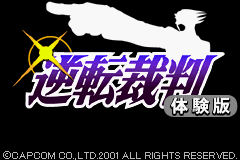
For some reason Gyakuten Saiban 2 contains the demo version title screen from the first game.
Background Placeholder 1

A background placeholder that says "Two chatting persons" or something like that. It only appears in the GBA version.
Unused Graphics (DS)
Demo Version Image
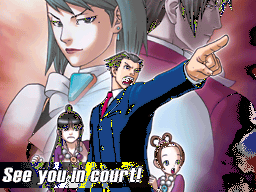
The ending screen from the demo version. Some pixels have wrong color because the image was not appropriately converted for the game (it uses the first 32 palette colors that are reserved for UI purposes).
Unlock all Episodes Promt

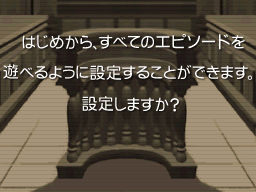
The Japanese version allows to unlock all cases if the GBA version of Gyakuten Saiban 2 is present in the GBA cartridge slot. Since the DS version is the first release of the game outside Japan, this feature was removed but the corresponding images were not.
Background Placeholder 2
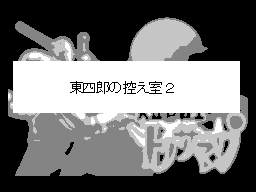
(Toshiro's Defendant Lobby No. 2)
The GBA and DS versions also contain another background placeholder that apparently says "Toshiro's Defendant Lobby No. 2".
It is not quite clear who this Toshiro is: there is no one with such name among the developer stuff of this or the previous game. Moreover, the Defendant Lobby background was created for the first game and had been used since then without any changes.
In the second game there is only one background besides the usual one that features the Defendant Lobby: the intro scene from the first case, The Lost Turnabout, where Phoenix sits on a couch on the right and Wellington stands with a fire extinguisher on the left. Incidentally, this scene occurs in the Defendant Lobby No. 2.

One might think Toshiro is the Japanese name of Richard Wellington, but in that version he is called Takamasa Moroheiya.
Given the situation though, it is possible that Toshiro was the original Japanese name of this character.
Rise from the Ashes Button

There is a Rise from the Ashes episode select button left from the first game. This fact also shows that the second game was ported directly over the first one.
Unused Background Thumbnail
Background thumbnails are used on the lower screen when you highlight or choose a location entry.
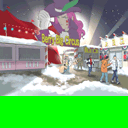
Since the player never gets a chance to visit Berry Big Circus at night this thumbnail goes unused.
Unused Animations
Manfred von Karma
.gif)
Manfred von Karma makes his appearance in the second game, albeit only during reminiscence scenes.
He has three unique animations in the game files — this being the only one that never appears in the game.
Unused Sprites
All unused sprites below could only be found in the Art of Gyakuten Saiban book — they are not present in the game files in any form.
Mia Fey (Pearl)
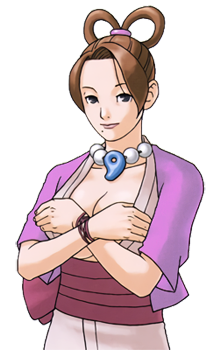
It is hard to say whether this rather risqué sprite was meant to appear in the game or if it was a tonque-in-cheek joke, but it looks similar to Mia's default sprite when she is channeled by Pearl.
Then again this and the following game contain implicit phallic symbols, so who knows...
Pearl Fey

This sprite looks the same as Pearl's default one, except here she is blushing. It is quite possible at one point Pearl had a separate blushing animation.
Maggey Byrde
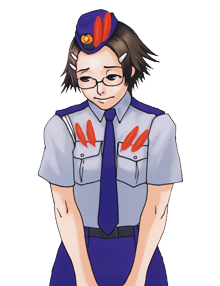
Most likely this sprite was removed since there already was another similar sprite.
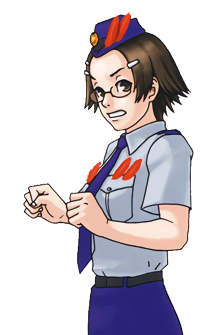
Another unused sprite where Maggey looks taken aback. I guess it was also meant to connect the other two sprites.
Adrian Andrews

This sprite would eventually find its use in Ace Attorney — Trials and Tribulations, but there is a possibility it was originally made for the second game, since in the Art of Gyakuten Saiban book it is depicted with her top being blue like in Justice for All, instead of being black like in Trials and Tribulations. On the other hand, her hairstyle looks like that from Trials and Tribulations, which speaks against this possibility.
Richard Wellington
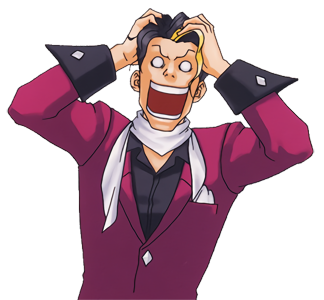
The Art of Gyakuten Saiban lists it under the title コワレ (breakdown), and as the name suggests, this sprite was part of Wellington's breakdown animation.
It is also worth to mention that originally his costume was red instead of blue.
Early Sprite Design
First of all, it should be stated that the following images are definitely not character artworks — they were clearly intended to be used in the game. Their poses and general similarities to the sprites featured in the game further prove this point.
When doing a comparison keep in mind that the color hues do not match the way they originally appeared, due to the fact that those stills were obtained from imperfect paper scans.
The images below do not appear in the game files in any form.
Pearl Fey

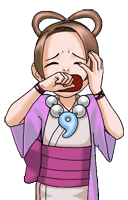


In the final game when Pearl is crying she only moves her right hand, while the left hand stays in one place, but in the earlier version of this animation she wiped her eyes with both hands.
Unused Music
Because the second game was ported directly over the first one, it contains several leftover music tracks from Phoenix Wright Ace Attorney:
- Maya Fey ~ Turnabout Sisters' Theme 2001
- Ace Attorney ~ End (Credits Theme)
- Unknown Track BGM009 (Unused Track from AA1)
- Jingle ~ It Can't End Here (Save Jingle)
- Ace Attorney ~ Prologue (AA1 Case 1 Intro)
- Investigation ~ Opening 2001
- Marvin Grossberg ~ Age, Regret, Retribution
- Reminiscence ~ Heartbroken Maya
Trivia
Here I will describe some small but interesting tidbits that do not belong elsewhere.
Starting from the Nintendo DS re-release a lobster's tail in Viola Hall was censored out in both the Japanese and overseas versions due to its suggestive look:


This background stayed censored in all subsequent versions up to the 3DS re-release, where it finally appeared in its full glory again.
Surprisingly, there is another instance of censorship, only this time it went the other way around:
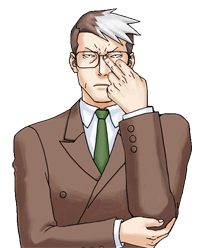

Before the arrival of the 3DS re-release, Dr. Grey brought his glasses back with the middle finger, but for the 3DS release he was redrawn to use his index finger instead. This change affected both English and Japanese versions, and was also carried into the latest Trilogy HD re-release.
Now this change makes perfect sense, but it begs the question of why someone bothered to edit out a harmless lobster's tail, yet at the same time left the more offensive middle finger gesture intact.
Since the game was ported over the first one, it also contains all its garbage graphics, like the Japanese GBA Bubbles, GBA UI Buttons, Language Buttons an so on.
